| |
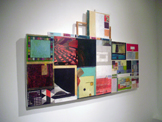
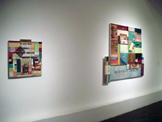
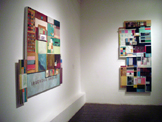
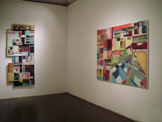
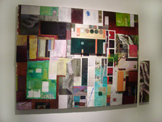
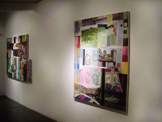
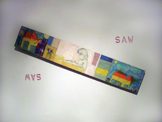
|
2010
Nov. 30th to Dec. 23rd - Paintstructures | Geraldo Souza Dias
Solo Exhibition
Structurally
by Marcio Harum
From any possible point the beholder of the exhibition “Pain-T-Structures – Painterly Structures” by Geraldo Souza Dias, there will be the view of an intense mingling of vertical and horizontal planes, such as a living warehouse of colors and paints of his collaged oil paintings on canvas and wood.
The center of the exhibition room can be perhaps perceived, on a multilevel basis, as a square surrounded by buildings of well varied height: a sense of precedence of the look will recognize immediately parts, but not the entire set. The surrounding works allude to another place, to a visual language compartmented in signs, like the themes ordered by groups of pages in a practical notebook, that now has been stretched on canvas.
The use of stencil and watermarks on paper confirm the infiltration of different techniques in the artist’s practice. Resorting to juxtaposing side by side bare stretchers and empty canvases, his artistic production is conducted consciously in order to escape from the conventional format of the picture plane.
Keywords in foreign language serve as structure to the corpus of the catalog of memorable addresses of Souza Dias (some of them are represented, such as the buildings of the Faculty of Architecture and Urbanism of University of São Paulo, the Olympic Stadium in Berlin and the School of Arts and Communications of USP). The painted nature of a waterfall or a mountain appears on canvas as the momentary result of ordering; not withstanding, occurs, in parallel, a flagrant entanglement of mysterious images (the digital of a thumb, a boy with a spine on the foot, a kiss): a fragmented mirror as a metaphor of painting itself.
However, technical drawings and architectural sketches are reunited to cultural codes which allude to matter and actual information of the art world (art exhibition folders pasted on the stretcher in apparent displacement, for example).
The artist’s family, a resistance piece in the exhibition, translates linguistically through its pendulum like little movements; the changing into structure of an artifact that covers the painting while marks the passage of time, between past and present.
With a certain degree of faithfulness to the appearance with the restrict field to urban advertisements, there is an announcing place in Souza Dias’ work in painting and collage that absolutely does not compromise with the game of marked cards.
|